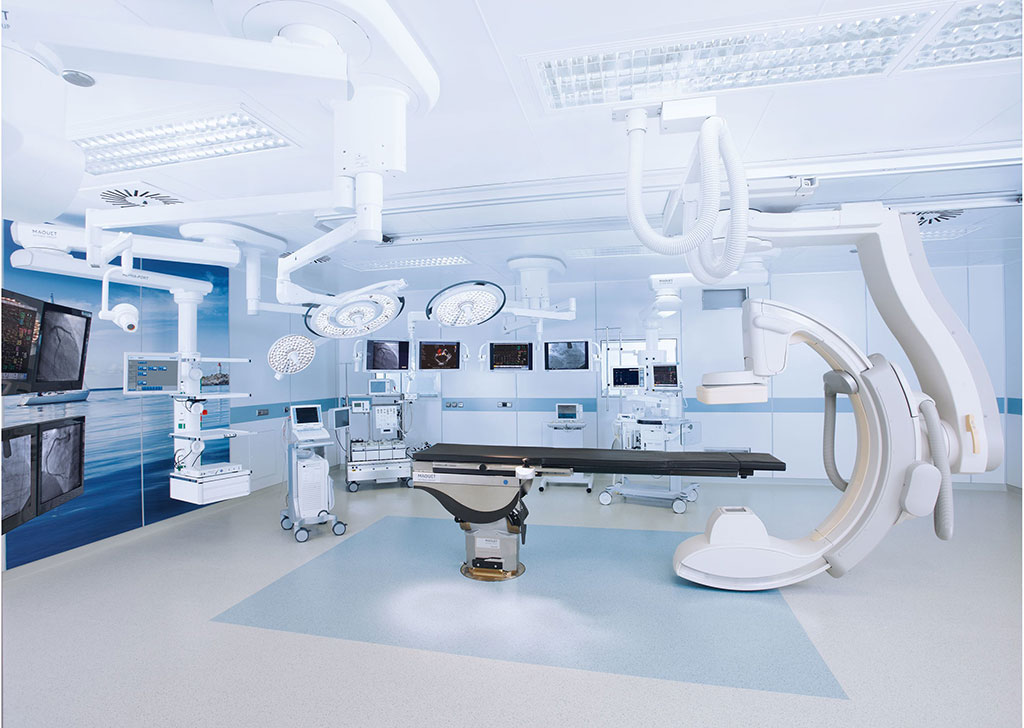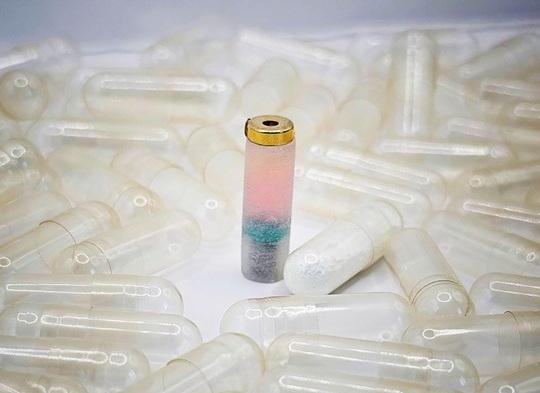Augmented Reality Surgical Navigation Minimizes Radiation Exposure
|
By HospiMedica International staff writers Posted on 24 Feb 2020 |

Image: A hybrid OR equipped with the Allura Clarity Flexmove robotic C-arm (Photo courtesy of Maquet)
A new study suggests that using an augmented reality surgical navigation (ARSN) system in a hybrid operating room (OR) environment can minimize occupational radiation exposure.
Researchers at Karolinska University Hospital (Stockholm, Sweden), the Karolinska Institutet (KI; Solna, Sweden), and Philips Healthcare (Philips; Best, the Netherlands) conducted a study involving 20 patients scheduled for spine surgery with pedicle screw placement. The surgical procedures were performed in a hybrid OR using the ceiling-mounted Philips Allura Clarity Flexmove robotic C-arm, with the aid of an integrated ARSN system.
Two dimensional (2D) fluoroscopy imaging was used for spinal level identification and an intraoperative cone beam computerized tomography (CBCT) image was acquired for navigation planning and screw placement. Another CBCT was performed to confirm correct screw placement prior to wound closure, instead of a postoperative CT. Staff radiation exposure was measured using real-time active personnel dosimeters, and was further compared with measurements using a reference dosimeter attached to the C-arm. Patient radiation exposure characteristics were extracted from radiation dose structured reports (RDSR) in order to estimate effective doses (ED).
The results revealed that average staff-to-reference dose ratio per procedure was 0.05%, and decreased to less than 0.01% after a few procedures had been performed using the ARSN. Average patient ED was mainly correlated with the number of vertebrae treated and the number of CBCTs performed. The low-dose protocol used for the final 10 procedures yielded a 32% ED reduction per spinal level treated. The researchers added that using real-time active personnel dosimeters contributed to fast optimization and adoption of protective measures throughout the study. The study was published on January 1, 2020, in Spine.
“Patient radiation dose was reduced by using a low-dose protocol with fewer x-ray pulses per second and a larger field of view, thereby improving the ratio between number of imaged spinal levels and total dose,” concluded lead author Erik Edström, MD, PhD, of KI, and colleagues. “This study demonstrates that relatively low patient radiation doses are possible with an ARSN system for spine surgery in a hybrid OR.”
The use of 3D imaging obtained by a C-arm or a computed tomography (CT) system for intraoperative pedicle screw planning, placement, assessment, and revision has increased substantially. When used in conjunction with an ASRD system, the risk of screw misplacement is significantly reduced. And although the technique may increase total radiation exposure (compared to fluoroscopy), occupational exposure can be minimized, as ARSN is radiation free, and staff can be positioned behind protective shielding during imaging.
Related Links:
Karolinska University Hospital
Karolinska Institutet
Philips Healthcare
Researchers at Karolinska University Hospital (Stockholm, Sweden), the Karolinska Institutet (KI; Solna, Sweden), and Philips Healthcare (Philips; Best, the Netherlands) conducted a study involving 20 patients scheduled for spine surgery with pedicle screw placement. The surgical procedures were performed in a hybrid OR using the ceiling-mounted Philips Allura Clarity Flexmove robotic C-arm, with the aid of an integrated ARSN system.
Two dimensional (2D) fluoroscopy imaging was used for spinal level identification and an intraoperative cone beam computerized tomography (CBCT) image was acquired for navigation planning and screw placement. Another CBCT was performed to confirm correct screw placement prior to wound closure, instead of a postoperative CT. Staff radiation exposure was measured using real-time active personnel dosimeters, and was further compared with measurements using a reference dosimeter attached to the C-arm. Patient radiation exposure characteristics were extracted from radiation dose structured reports (RDSR) in order to estimate effective doses (ED).
The results revealed that average staff-to-reference dose ratio per procedure was 0.05%, and decreased to less than 0.01% after a few procedures had been performed using the ARSN. Average patient ED was mainly correlated with the number of vertebrae treated and the number of CBCTs performed. The low-dose protocol used for the final 10 procedures yielded a 32% ED reduction per spinal level treated. The researchers added that using real-time active personnel dosimeters contributed to fast optimization and adoption of protective measures throughout the study. The study was published on January 1, 2020, in Spine.
“Patient radiation dose was reduced by using a low-dose protocol with fewer x-ray pulses per second and a larger field of view, thereby improving the ratio between number of imaged spinal levels and total dose,” concluded lead author Erik Edström, MD, PhD, of KI, and colleagues. “This study demonstrates that relatively low patient radiation doses are possible with an ARSN system for spine surgery in a hybrid OR.”
The use of 3D imaging obtained by a C-arm or a computed tomography (CT) system for intraoperative pedicle screw planning, placement, assessment, and revision has increased substantially. When used in conjunction with an ASRD system, the risk of screw misplacement is significantly reduced. And although the technique may increase total radiation exposure (compared to fluoroscopy), occupational exposure can be minimized, as ARSN is radiation free, and staff can be positioned behind protective shielding during imaging.
Related Links:
Karolinska University Hospital
Karolinska Institutet
Philips Healthcare
Latest Surgical Techniques News
- Minimally Invasive Endoscopic Surgery Improves Severe Stroke Outcomes
- Novel Glue Prevents Complications After Breast Cancer Surgery
- Breakthrough Brain Implant Enables Safer and More Precise Drug Delivery
- Bioadhesive Sponge Stops Uncontrolled Internal Bleeding During Surgery
- Revolutionary Nano Bone Material to Accelerate Surgery and Healing
- Superior Orthopedic Implants Combat Infections and Quicken Healing After Surgery
- Laser-Based Technique Eliminates Pancreatic Tumors While Protecting Healthy Tissue
- Surgical Treatment of Severe Carotid Artery Stenosis Benefits Blood-Brain Barrier
- Revolutionary Reusable Duodenoscope Introduces 68-Minute Sterilization
- World's First Transcatheter Smart Implant Monitors and Treats Congestion in Heart Failure
- Hybrid Endoscope Marks Breakthrough in Surgical Visualization
- Robot-Assisted Bronchoscope Diagnoses Tiniest and Hardest to Reach Lung Tumors
- Diamond-Titanium Device Paves Way for Smart Implants that Warn of Disease Progression
- 3D Printable Bio-Active Glass Could Serve as Bone Replacement Material
- Spider-Inspired Magnetic Soft Robots to Perform Minimally Invasive GI Tract Procedures
- Micro Imaging Device Paired with Endoscope Spots Cancers at Earlier Stage
Channels
Critical Care
view channel
AI Heart Attack Risk Assessment Tool Outperforms Existing Methods
For decades, doctors have relied on standardized scoring systems to assess patients with the most common type of heart attack—non-ST-elevation acute coronary syndrome (NSTE-ACS). The GRACE score, used... Read more
'Universal' Kidney to Match Any Blood Type
Blood-type incompatibility has long been one of the greatest obstacles in organ transplantation, forcing thousands of patients—particularly those with type O blood—to wait years longer for compatible donors.... Read morePatient Care
view channel
Revolutionary Automatic IV-Line Flushing Device to Enhance Infusion Care
More than 80% of in-hospital patients receive intravenous (IV) therapy. Every dose of IV medicine delivered in a small volume (<250 mL) infusion bag should be followed by subsequent flushing to ensure... Read more
VR Training Tool Combats Contamination of Portable Medical Equipment
Healthcare-associated infections (HAIs) impact one in every 31 patients, cause nearly 100,000 deaths each year, and cost USD 28.4 billion in direct medical expenses. Notably, up to 75% of these infections... Read more
Portable Biosensor Platform to Reduce Hospital-Acquired Infections
Approximately 4 million patients in the European Union acquire healthcare-associated infections (HAIs) or nosocomial infections each year, with around 37,000 deaths directly resulting from these infections,... Read moreFirst-Of-Its-Kind Portable Germicidal Light Technology Disinfects High-Touch Clinical Surfaces in Seconds
Reducing healthcare-acquired infections (HAIs) remains a pressing issue within global healthcare systems. In the United States alone, 1.7 million patients contract HAIs annually, leading to approximately... Read moreHealth IT
view channel
Printable Molecule-Selective Nanoparticles Enable Mass Production of Wearable Biosensors
The future of medicine is likely to focus on the personalization of healthcare—understanding exactly what an individual requires and delivering the appropriate combination of nutrients, metabolites, and... Read moreBusiness
view channel
Philips and Masimo Partner to Advance Patient Monitoring Measurement Technologies
Royal Philips (Amsterdam, Netherlands) and Masimo (Irvine, California, USA) have renewed their multi-year strategic collaboration, combining Philips’ expertise in patient monitoring with Masimo’s noninvasive... Read more
B. Braun Acquires Digital Microsurgery Company True Digital Surgery
The high-end microsurgery market in neurosurgery, spine, and ENT is undergoing a significant transformation. Traditional analog microscopes are giving way to digital exoscopes, which provide improved visualization,... Read more
CMEF 2025 to Promote Holistic and High-Quality Development of Medical and Health Industry
The 92nd China International Medical Equipment Fair (CMEF 2025) Autumn Exhibition is scheduled to be held from September 26 to 29 at the China Import and Export Fair Complex (Canton Fair Complex) in Guangzhou.... Read more













